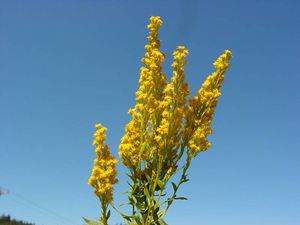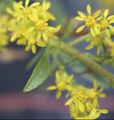Difference between revisions of "Solidago missouriensis"
m (→Photo Gallery) (Tag: VisualEditor) |
(→Photo Gallery) (Tag: VisualEditor) |
||
| Line 1: | Line 1: | ||
| + | * Scientific Name: ''Solidago missouriensis'' | ||
| + | * Family: Asteraceae | ||
| + | * Common Names: Missouri goldenrod | ||
| + | * Codon: SOLMIS | ||
[[File:SOLMIS1.jpg|thumb|G.D. Carr 2010]] | [[File:SOLMIS1.jpg|thumb|G.D. Carr 2010]] | ||
| − | + | ==Taxnomy== | |
| − | == | + | {{Taxobox |
| − | + | | name = Solidago missoursiensis | |
| − | + | | regnum = [[Plant]]ae | |
| − | + | | subregnum = Tracheobionta | |
| − | + | | phylum = Spermatophyta | |
| − | + | | subphylum= Magnoliophyta | |
| − | + | | classis = Magnoliopsida | |
| − | + | | subclassis = Asteranae | |
| − | + | | ordo = Asterales | |
| − | + | | familia = Asteraceae | |
| − | + | | genus = '''''Solidago''''' L. | |
| − | + | | species = '''''Solidago missouriensis'''' Nutt | |
| + | | subspecies = | ||
| + | }} | ||
==Description== | ==Description== | ||
| Line 19: | Line 25: | ||
Leaves: Leaves tending to be triple-nerved, the basal ones oblanceolate, up to 30 cm. long and 3 cm. wide, the others smaller and becoming sessile upward. | Leaves: Leaves tending to be triple-nerved, the basal ones oblanceolate, up to 30 cm. long and 3 cm. wide, the others smaller and becoming sessile upward. | ||
| − | Flowers: Involucre 3-5 mm. high; rays usually 8, yellow. | + | Flowers: Involucre 3-5 mm. high; rays usually 8, yellow.<ref>WTU Herbarium, Burke Museum, |
| + | & University of Washington. Retrieved from <nowiki>https://biology.burke.washington.edu/herbarium/imagecollection/taxon.php?Taxon=Solidago%20missouriensis</nowiki></ref> | ||
==Bloom Period== | ==Bloom Period== | ||
| Line 29: | Line 36: | ||
==Habitat== | ==Habitat== | ||
Rather dry, open places, from the valleys and plains to fairly high elevations in the mountains. | Rather dry, open places, from the valleys and plains to fairly high elevations in the mountains. | ||
| − | |||
| − | |||
| − | |||
| − | |||
| − | |||
==Propagation== | ==Propagation== | ||
| Line 41: | Line 43: | ||
==Photo Gallery== | ==Photo Gallery== | ||
| − | + | <gallery> | |
| + | SOMI GDCarr veg good.jpg| Photo GD Carr | ||
| + | SOLMIS2.jpg| Photo CNLM | ||
| + | SOLMIS5.png| Photo CNLM | ||
| + | SOLMIS3.jpg| Solidago seedling, courtesy CNLM | ||
| + | </gallery> | ||
==References== | ==References== | ||
<references /> | <references /> | ||
Revision as of 00:39, 22 April 2020
- Scientific Name: Solidago missouriensis
- Family: Asteraceae
- Common Names: Missouri goldenrod
- Codon: SOLMIS
Contents
Taxnomy
| Solidago missoursiensis | |
|---|---|
| Scientific classification | |
| Kingdom: | Plantae |
| Subkingdom: | Tracheobionta |
| Phylum: | Spermatophyta |
| Subphylum: | Magnoliophyta |
| Class: | Magnoliopsida |
| Subclass: | Asteranae |
| Order: | Asterales |
| Family: | Asteraceae |
| Genus: | Solidago L. |
| Species: | Solidago missouriensis' Nutt |
Description
General: Glabrous perennial from a creeping rhizome, 2-9 dm. tall.
Leaves: Leaves tending to be triple-nerved, the basal ones oblanceolate, up to 30 cm. long and 3 cm. wide, the others smaller and becoming sessile upward.
Flowers: Involucre 3-5 mm. high; rays usually 8, yellow.[1]
Bloom Period
Late June-October
Distribution
Southern British Columbia and western Washington, east to Ontario and Tennesse.
Habitat
Rather dry, open places, from the valleys and plains to fairly high elevations in the mountains.
Propagation
Plants established by seedlings can be started by sowing seed in containers in January and placed in a greenhouse. Seed should be covered lightly with soil and kept moist until germination. A layer of pea gravel can be applied to the soil surface to prevent seeds from floating. Seeds planted in this manner will begin germination about Day 7 and complete germination by Day 14. [2]
Photo Gallery
References
- ↑ WTU Herbarium, Burke Museum, & University of Washington. Retrieved from https://biology.burke.washington.edu/herbarium/imagecollection/taxon.php?Taxon=Solidago%20missouriensis
- ↑ Skinner, D. 2004. Propagation protocol for production of container Solidago missouriensis Nutt. Plants; USDA NRCS Plant Materials Center, Pullman, WA.




